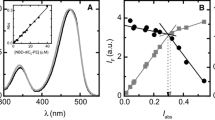Abstract.
The chemical selectivities of the transport barriers in lipid bilayers varying in composition and phase structure (gel-phase DPPC and DHPC bilayers and liquid-crystalline DPPC/CHOL/50:50 mol% bilayers) have been investigated by determining functional group contributions to transport of a series of α-substituted p-toluic acid analogs obtained in vesicle efflux experiments. Linear free energy relationships are established between the free energies of transfer for this series of compounds from water to the barrier domain and corresponding values for their transfer from water into six model bulk solvents (hexadecane, hexadecene, decadiene, chlorobutane, butyl ether, and octanol) determined in partitioning experiments to compare the barrier microenvironment to that in these model solvents. The barrier microenvironment in all bilayers studied is substantially more hydrophobic than octanol, thus establishing the location of the barrier beyond the hydrated headgroup interfacial region, as the interface is expected to be more hydrophilic than octanol. The chemical nature of the barrier domain microenvironment varies with bilayer phase structure. The barrier regions in non-interdigitated DPPC and interdigitated DHPC gel-phase bilayers exhibit some degree of hydrogen-bond acceptor capacity as may occur if these domains lie in the vicinity of the ester/ether linkages between the headgroups and the acyl chains. Intercalation of 50 mol% cholesterol into DPPC bilayers, which induces a phase transition to a liquid-crystalline phase, substantially increases the apparent barrier domain hydrophobicity relative to gel-phase bilayers to a nonhydrogen bonding, hydrocarbonlike environment resembling hexadecene. This result, combined with similar observations in liquid-crystalline egg-PC bilayers (J. Pharm. Sci. (1994), 83:1511–1518), supports the notion that the transition from the gel-phase to liquid-crystalline phase shifts the barrier domain further into the bilayer interior (i.e., deeper within the ordered chain region).
Similar content being viewed by others
Author information
Authors and Affiliations
Additional information
Received: 16 September 1997/Revised: 14 May 1998
Rights and permissions
About this article
Cite this article
Xiang, TX., Xu, YH. & Anderson, B. The Barrier Domain for Solute Permeation Varies With Lipid Bilayer Phase Structure. J. Membrane Biol. 165, 77–90 (1998). https://doi.org/10.1007/s002329900422
Issue Date:
DOI: https://doi.org/10.1007/s002329900422




